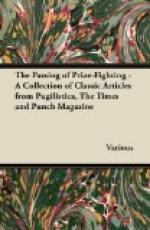An important and advantageous arrangement in the transactions of the society, since its foundation, has been the institution of the classes “for the acquisition of a general smattering of everything,” more especially as concerning the younger branches of society. It is, however, much to be regretted, that the public examination of the juvenile members, upon the subjects they had listened to during the past course, did not turn out so well as the committee could have wished. The various professors had taken incredible pains to teach the infant philosophers correct answers to the separate questions that would be asked them, in order that they might reply with becoming readiness. Unfortunately the examiner began at the wrong end of the class, and threw them all out, except the middle one. We sub-join a few of the questions:—
State the distance, in miles, from the Hanwell Lunatic Asylum to the Tuesday in Easter week, and show how long a man would be going from one to the other, if he travelled at the rate of four gallons a minute.
Required to know the advantages of giving tracts to poor people who cannot read, and how many are equivalent to a sliding-scale penny buster, in the way of nourishment.
“Was Lord John Russell in his Windsor uniform, ever mistaken for a two-penny postman; if so, what great man imagined the affinity?
[Illustration: Best Pigtail]
The School of Design and Drawing has made very creditable progress, and the subscribers will be gratified in learning, that one of the pupils sent in a design for the Nelson Testamonial, which would in all probability have been accepted, had not the decision been made in the usual preconcerted underhand manner. Following the columnar idea of Mr. Railton, our talented pupil had put forth a peculiarly appropriate idea: the shaft would have been formed by a sea-telescope of gigantic proportions, pulled out to its utmost extent. On the summit of this Nelson would have been seated, as on the maintop, smoking his pipe, from which real smoke would have issued. This would have been produced by a stove at the bottom of the column, whose object was to furnish a steady supply of baked potatoes, uninfluenced by the fluctuations of the market, to the cabmen of Trafalgar-square, and the street-sweepers at Charing-cross. The artist who designed the elegant structure at King’s-cross, which partakes so comprehensively of the attributes of a pump, a watch-house, a lamp-post, and a turnpike, would have superintended its erection, and a carved figure-head might have been purchased, for a mere song, to crown the elevation. It would not have much mattered whether the image was intended for Nelson or not, because, from its extreme elevation, no one, without a spy-glass, could have told one character from another—Thiers from Lord John Russell, George Steevens from Shakspere, Muntz from the Duke of Brunswick, or anybody else.
THE MUSEUM.




